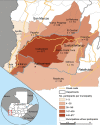Clinical and Economic Impact of COVID-19 on Agricultural Workers, Guatemala1
- PMID: 36502430
- PMCID: PMC9745239
- DOI: 10.3201/eid2813.212303
Clinical and Economic Impact of COVID-19 on Agricultural Workers, Guatemala1
Abstract
We evaluated clinical and socioeconomic burdens of respiratory disease in banana farm workers in Guatemala. We offered all eligible workers enrollment during June 15-December 30, 2020, and annually, then tracked them for influenza-like illnesses (ILI) through self-reporting to study nurses, sentinel surveillance at health posts, and absenteeism. Workers who had ILI submitted nasopharyngeal swab specimens for testing for influenza virus, respiratory syncytial virus, and SARS-CoV-2, then completed surveys at days 0, 7, and 28. Through October 10, 2021, a total of 1,833 workers reported 169 ILIs (12.0 cases/100 person-years), and 43 (25.4%) were laboratory-confirmed infections with SARS-CoV-2 (3.1 cases/100 person-years). Workers who had SARS-CoV-2‒positive ILIs reported more frequent anosmia, dysgeusia, difficulty concentrating, and irritability and worse clinical and well-being severity scores than workers who had test result‒negative ILIs. Workers who had positive results also had greater absenteeism and lost income. These results support prioritization of farm workers in Guatemala for COVID-19 vaccination.
Keywords: COVID-19; Guatemala; SARS-CoV-2; agricultural workers; clinical impact; cohort; coronavirus disease; coronaviruses; economic impact; influenza virus; productivity; respiratory illness impact; respiratory infections; respiratory syncytial virus; severe acute respiratory syndrome coronavirus 2; severity; viruses; zoonoses.
Figures





References
-
- Duff A, Padilla A. Latin America: agricultural perspectives; 2015. [cited 2022 Mar 16]. https://economics.rabobank.com
Publication types
MeSH terms
Substances
Grants and funding
LinkOut - more resources
Full Text Sources
Medical
Miscellaneous

